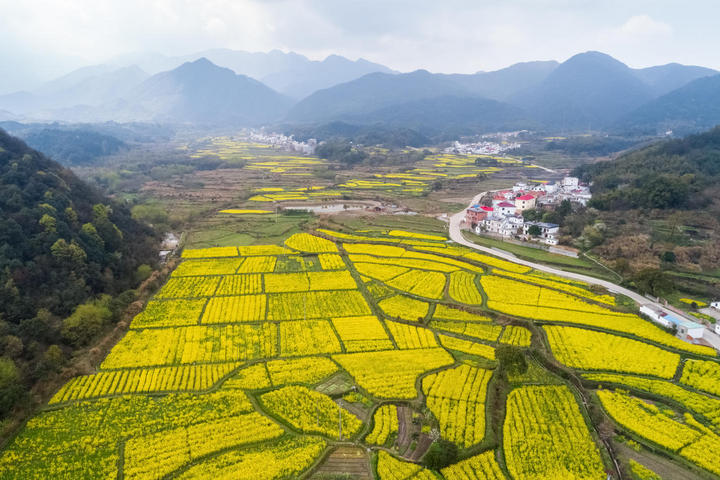


The internal driving force for expanding rapeseed production capacity has been strengthened, and there is an urgent demand for light, efficient, and green planting technologies in winter rapeseed production. Since 2016, Huazhong Agricultural University, the National Agricultural Technology Extension Service Center, and the Hubei Provincial Rape Office have been conducting research on the key technical links and technical parameters of the zero tillage, aerial seeding, and full return of rice straw to the field light, simple, and efficient planting mode for rapeseed in rice fields in Hubei, Jiangxi, Hunan, and other provinces, After 4 years of research and demonstration, an efficient, light, and green planting mode has been established, which involves key technical aspects such as drone aerial seeding of rapeseed seeds before rice harvesting, machine harvesting of rice with high stakes, one-time application of rapeseed specific slow-release fertilizer, mechanical trenching, and green prevention and control. This technology model has the following advantages: sowing in a window period of about 2 to 3 days before and after rice harvest, reducing the plowing and tidying process after rice harvest, saving more than 1 week of time, and effectively solving the contradiction of stubble during rice oil rotation; It can effectively utilize the soil moisture of rice fields and promote the germination of rapeseed seeds; Except for certain limitations on the sowing time of rapeseed, other field operation times can be flexibly arranged; Large harvesters, while harvesting rice, use equipment such as straw crushing and returning to the field, drone aerial seeding, and mechanical trenching to significantly improve the mechanization of rapeseed production, reduce labor intensity and labor costs, and increase farmers’ enthusiasm for planting; When mechanically harvesting rice, straw is left on high stakes and crushed in situ to solve the problem of straw treatment when planting rapeseed. At the same time, it can fully utilize the functions of straw covering and returning to the field to preserve moisture, suppress weeds, and improve soil organic matter, which is conducive to efficient and green production of rapeseed. In the past three years, large-scale demonstrations have been conducted in major rapeseed producing provinces such as Hubei, Jiangxi, Hunan, and Anhui. The results show that the rice fields planted with this technology have good yield stability, with an average yield of 165.9 kilograms per mu and a high yield demonstration plot of 220 kilograms per mu. The input cost per mu can be controlled between 270 to 320 yuan. In addition to the input cost, the income per mu exceeds 500 yuan, and the cost saving and income increasing effect is significant.2、 Technical points1. Previous management. In the later stage of the rice field, it is appropriate to retain entropy (soil moisture content of about 30%) and keep the harvester in the field without leaving deep marks. Rice combine harvester with straw smashing and throwing device is used to harvest rice with stubble height of 40-50cm, and straw is crushed and returned to the field evenly.2. Drone aerial broadcasting. Before and after the rice harvest, agricultural drones are used to sow rapeseed by air, and suitable early to medium maturing high-quality rapeseed varieties are selected. In the first ten days of October, the fields with stubble will be aerial sown with rapeseed within three days before and after rice harvest, with a seed amount of 300-350 grams per mu; In mid October, if the stubble is harvested, it should be sown by air 1-3 days before the rice harvest, with a seed yield of about 300 grams per mu; In late October, when the crop is harvested, it should be sown 3-5 days before the rice harvest, with a seed yield of 350-400 grams per mu. As the sowing date is postponed, the amount of seed used will increase accordingly. The suitable sowing time is October, and the sowing date should not be later than early November. The maximum amount of seed used per mu should not exceed 500 grams.3. Scientific fertilization. After the rice harvest and rapeseed sowing are completed, fertilizer can be sprayed mechanically or manually. The disposable base fertilizer can be selected as Yishi Zhuangzhuang special slow-release fertilizer for rapeseed (N-P2O5-K2O is 25-7-8, and contains medium and trace elements such as Ca, Mg, S, B) or other similar formula rapeseed special fertilizer, with a dosage of about 40 kilograms per mu. The fertilization operation can be carried out within 10 days after the sowing of rapeseed, and in principle, it should be done early rather than late.4. Mechanical trenching. After the sowing and fertilization are completed, use a trenching machine to make a trench, and the soil in the trench will be divided and thrown onto the surface of the trench. The width of the compartment is 2-2.5m, the depth of the compartment ditch is 25-30cm, and the width of the ditch is about 25cm. The depth of the waist ditch is 30-32cm, and the width is about 30cm. The depth of the surrounding ditch is 32-35cm, and the width is about 35cm. The three ditches of the compartment ditch, waist ditch, and surrounding ditch are connected to ensure smooth irrigation and drainage.5. Green prevention and control. The full amount of straw returned to the field has strong control ability, and generally, there is no need to weed the fields. For fields with serious perennial grass damage, when rape leaves are 4-5, spray the special herbicides for oil and vegetable fields, such as oleum (50% chlorpromazine 30ml+24% fenoxalone 40ml+isopropyl oxalate 45ml) once, which can be used by drones, field walking machines or manual spray. Spray 45% prochloraz 37.5 mL/mu using drones during the budding stage, and melt through 20 mL/mu with additives to prevent and control bacterial wilt disease; In the year of occurrence of sclerotinia disease, carbendazim, Junhejing, prochloraz and other agents were sprayed by UAV during the flowering period.3、 Suitable areaThis technology is suitable for planting rapeseed in rice fields in the Yangtze River Basin. This technique can be used when rice is harvested after late September, and the sowing date is generally no later than mid November. It is particularly suitable for planting models such as early rice late rice rapeseed, rice regenerated rice rapeseed, and one season late rice rapeseed.4、 Precautions1. This technology is not suitable for paddy fields that harvest rice before mid September.The symbiotic period between rapeseed and rice should generally not exceed 5 days.3. Key technologies such as high stakes, fertilization, and trenching for rice must be implemented in a coordinated manner. If neither fertilization nor trenching measures are followed, it will lead to technical failure.

没有reply内容